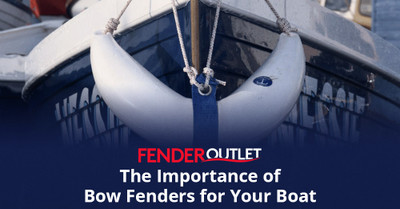26th Aug 2025
When it comes to protecting your boat, fenders are one of the simplest yet most effective investments you can make. They act as a barrier between your vessel and anything it might come into contact with - a pontoon, another boat, or a harbour wall. And while side fenders get most of the attention, the bow fender is often the unsung hero of boat protection. Positioned right at the front of your vessel, bow fenders are the first line of defence against knocks, bumps, and scrapes.
What Is a Bow Fender?
A bow fender is a specially designed bumper that attaches to the bow of your boat. Unlike side fenders, which are hung temporarily from guard rails or cleats, bow fenders are typically fixed more permanently in place. They’re built to absorb forward impacts, whether that’s nudging a pontoon as you come in to moor, making contact with a lock gate, or simply dealing with the natural movement of tides and currents in a busy marina.
Why Bow Fenders Are So Important
1. Protection During Mooring
The bow is often the first part of your boat to come into contact with a dock, pontoon, or jetty. A bow fender softens the blow, protecting your gelcoat, paintwork, or hull from scratches and dents. Without it, even a gentle approach can cause visible damage over time.
2. Extra Safety in Tight Spaces
In crowded harbours or busy locks, there’s little margin for error. A bow fender gives you confidence that if you do touch another surface, the impact will be cushioned. This is especially important for new skippers still getting used to handling their boat.
3. Preventing Costly Repairs
Bow damage can be more than cosmetic. Chips and cracks in the gelcoat can allow water ingress, leading to structural issues if left untreated. Installing a quality bow fender is a small investment compared to the cost of repairs or repainting.
4. Peace of Mind While Cruising
Even the most experienced helmsman can’t control every variable - from gusty winds to shifting currents. A bow fender acts as insurance, letting you focus on enjoying your time on the water instead of worrying about every approach and manoeuvre.
Types of Bow Fenders
Bow fenders come in a range of shapes, sizes, and materials to suit different boats:
Rope Bow Fenders:
Rope fenders are a traditional choice, often hand-made, that offers both function and a classic look. Commonly used on canal boats, barges, and classic craft.
Rubber or PVC Bow Fenders:
Hard-wearing and low-maintenance, ideal for everyday cruising and saltwater use. These are especially popular for yachts, motorboats, and RIBs.
Inflatable Bow Fenders:
Portable and easy to stow, inflatable fenders are perfect for boats that don’t want a fixed fender but still need bow protection when mooring.
Choosing the right style depends on your boat type, how often you use it, and where you do most of your boating.
How to Maintain Your Bow Fender
To keep your bow fender performing at its best, it’s important to give it a little regular care. Check it frequently for signs of wear and tear, paying close attention to the attachment points where fender ropes or fixings take the most strain. After each trip, especially if you’ve been out on saltwater, rinse the fender with fresh water to prevent salt and grime from causing damage. Over time, all fenders will naturally wear down, so if yours becomes cracked, flattened, or misshapen, it’s worth replacing to ensure it continues to provide proper protection.
A Small Investment, a Big Difference
Your bow is the leading edge of your boat, and it’s also one of the most vulnerable. A bow fender provides a simple, effective layer of defence that can save you from costly repairs, protect your boat’s appearance, and give you greater confidence every time you cast off.



